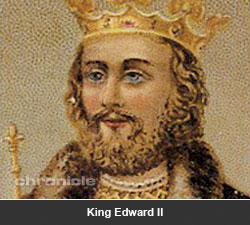
King Edward II
King Edward II (r. 1302-1327) succeeded to the throne in 1307. He was a weak and self-indulgent monarch and his reign is remembered as a time of internal conflict. Edward often gave his favourite nobles gifts and privileges beyond their stature, ignoring the hereditary rights or expectations of powerful lords and magnates. His insistence on the presence of one of his first favourites, Piers Gaveston, at court caused a revolt that ended with the beheading of Gaveston by the barons.
When Payn de Turberville, keeper of Caerphilly castle, began to remove Welsh men from office in the borough on the authority of the king, Llewelyn Bren appealed to Edward against the decision at Parliament in Lincoln. After he had been charged with sedition and inciting the Welsh to war, Llewelyn raised a revolt known as 'the war of Llewelyn Bren.'
On February 7th 1316, the king took steps to deal with the revolt, issuing a series of decrees that were to govern relations between the Welsh communities and Crown officials. Urgent steps were taken to deal with the Welsh in Glamorgan; forces were drafted in from neighbouring lordships and mercenaries drawn from West Wales. These forces defeated Llewelyn's men and lead to his imprisonment in the Tower of London.
By 1318, the Church and Baronage had shown increasing concern about Edward's new favourite, the powerful Hugh le Despenser, who was manipulating the feeble-minded king. In an effort to reduce Despenser's influence, they appointed an advisory body for the king to consult on all matters not involving Parliament.
In early 1321, the king became aware of the growing disaffection of the barons and their activity in the Marches. He ordered them not to hold assemblies or musters in their lordships and summoned the leaders of the Marcher opposition to meet him in council at Gloucester on the 5th of April. They refused to attend. The following month, the barons petitioned the king to dismiss Despenser. When the king refused, the barons took the law into their own hands, gathering 800 men-at-arms and 10,000 footmen and devastating Glamorgan from end to end.
In August, the barons forced Parliament to banish Despenser. The king was helpless in the face of the display of force and afraid that the northern barons might join the campaign of the Marcher lords. He summoned mercenary forces from abroad as well as an army of paid levies, under his direct control, for a fictitious Scottish campaign. On 16 February 1322, the king led his army into Glamorgan and bought the Marcher lords to their knees, arresting their supporters along the way. This campaign ensured that Despenser was recalled by March 1322. He was provided with an army and defeated the barons at the battle of Boughbridge in Yorkshire. Many of these rebel Barons met traitor's deaths. By May 2nd, Hugh had been restored to his former power at Parliament in York.
In February 1325, Queen Isabella, the she-wolf of France, journeyed to the continent on behalf of the king to negotiate on the issue of paying homage to Charles IV, her brother. She surrounded herself and her son with the King's enemies in France; most notably, Roger Mortimer; and refused to return whilst the king was under Despenser's power.
Isabella landed in East Anglia on September 24th, 1326, along with the remaining rebel barons and their Flemish and German Mercenary forces. As soon as the king realised the strength of the forces assembled against him, he fled to Bristol with his entourage, where they halted before trying to flee for Ireland by sea. However, contrary winds forced them to land in Cardiff. Despenser and the king stayed at Caerphilly castle, putting it into a state of defence, summoning troops and building up provisions.
Meanwhile, the queen established her headquarters in Hereford and placed the campaign for Glamorgan into the hands of Henry, Earl of Lancaster, Lord William la Zouche and Rhys ab Howel.
The king then fled from Caerphilly castle to Margam Abbey where he spent each night hiding in Gelli-y-Llenor farmhouse on the abbey grounds. On 16 November 1326, he was captured in a wood near Llantrisant along with Hugh le Despenser and Baldock. To prevent his escape and humiliate him further, Edward was forced to ride a pony to his place of imprisonment. He was put into custody at Kenilworth, whilst his son was made trustee of the realm in place of his father. These actions were carried out legally on the king's behalf because the queen had taken possession of the Great Seal.
Submitting to heavy pressure, the king abdicated and his son was crowned as Edward III on February 1st, 1327. Persistent attempts to rescue the Edward II lead to him being brutally tortured to death on September 21st, 1327.
“Mark the year and mark the night,
When Severn shall re-echo with afright:
The shrieks of death through Berkeley’s roofs that ring
The shrieks of an agonising King.”
Cray.
Image date: unknown
Location: unknown
Submitted by: unknown
Do you have any stories, images and interesting facts relating to this picture. Help Chronicle build a website of your Caerphilly County Borough memories. Email the webmaster telling us as much as you can about your pictures. Thank you
Description: